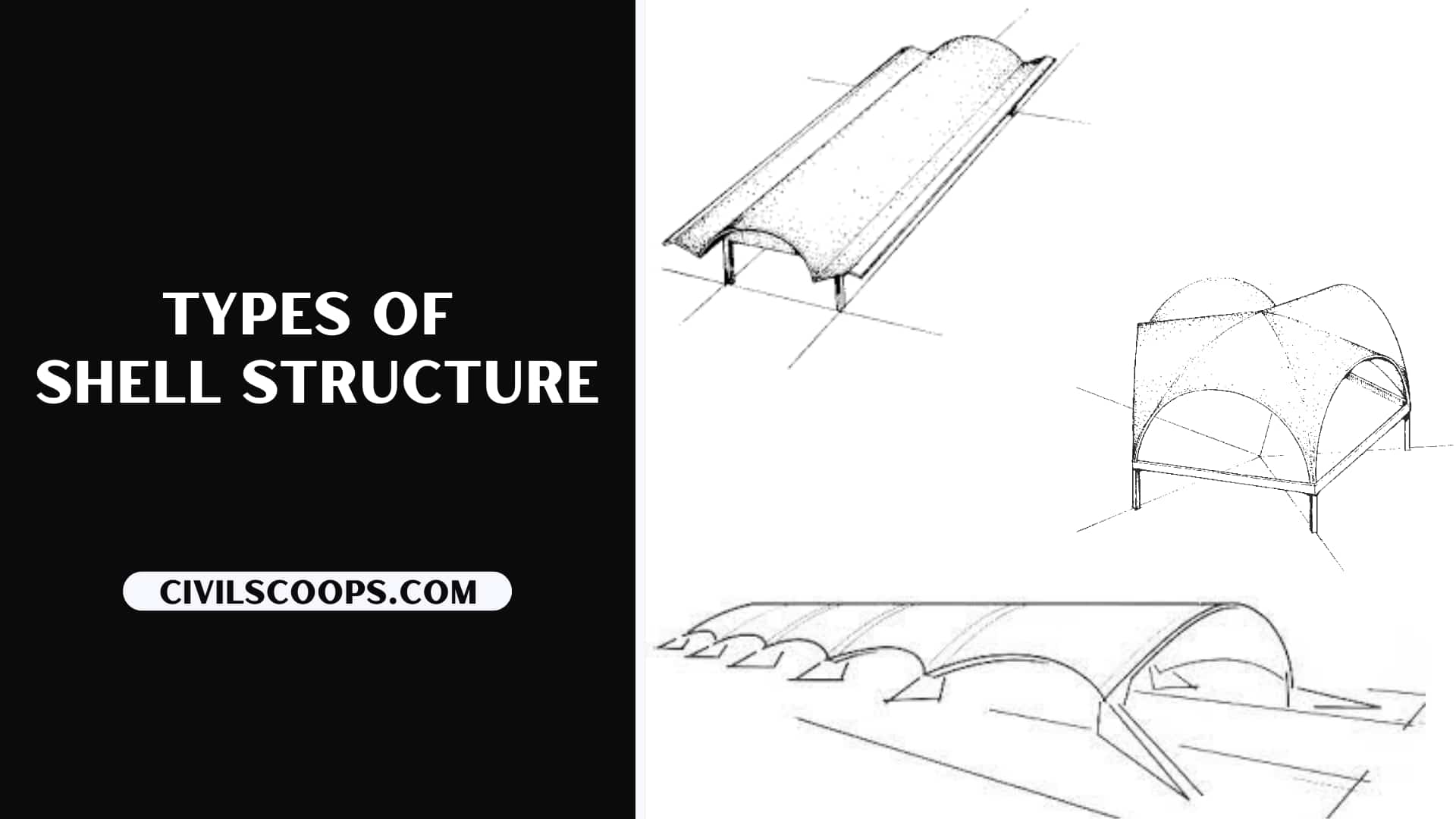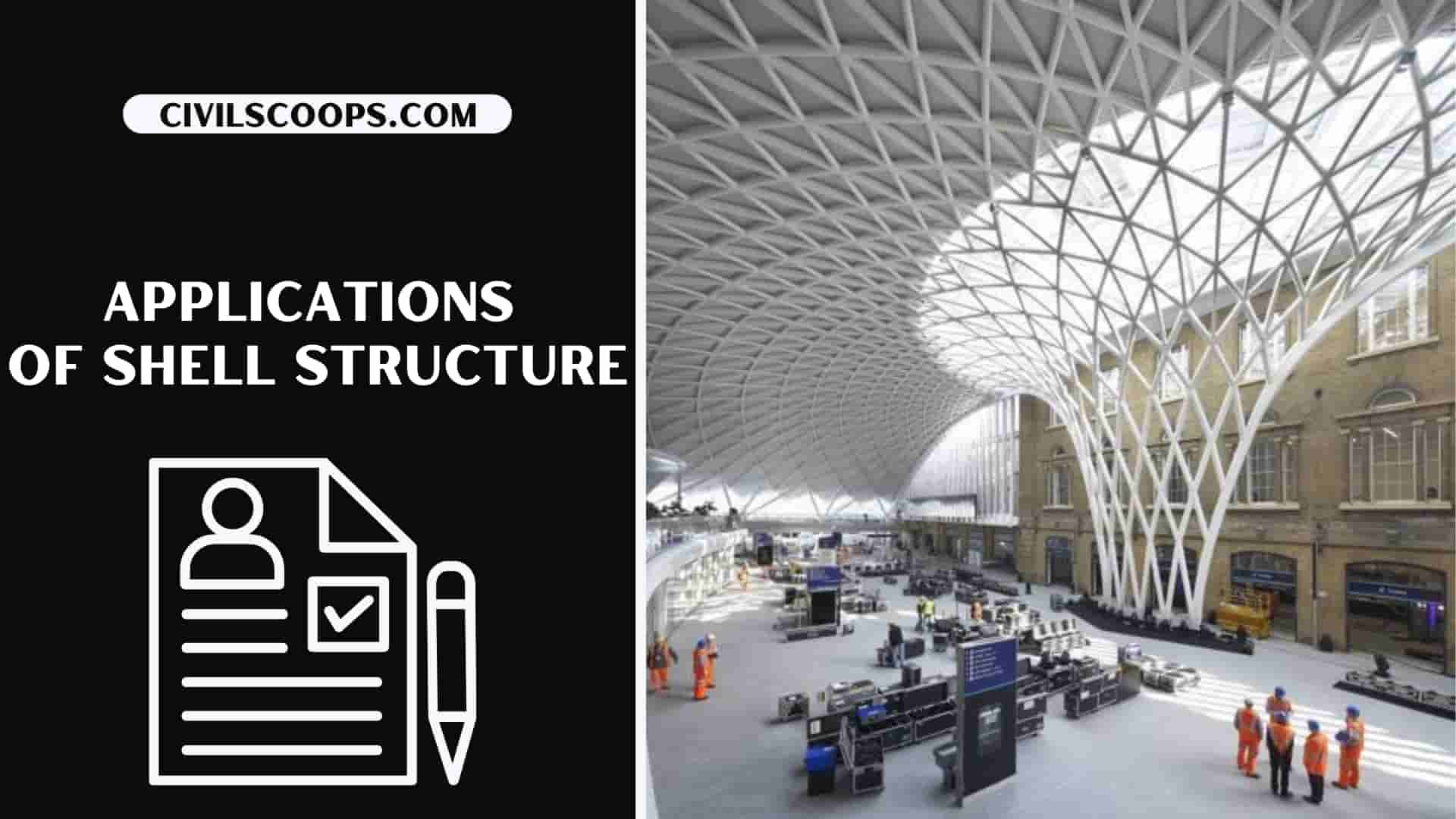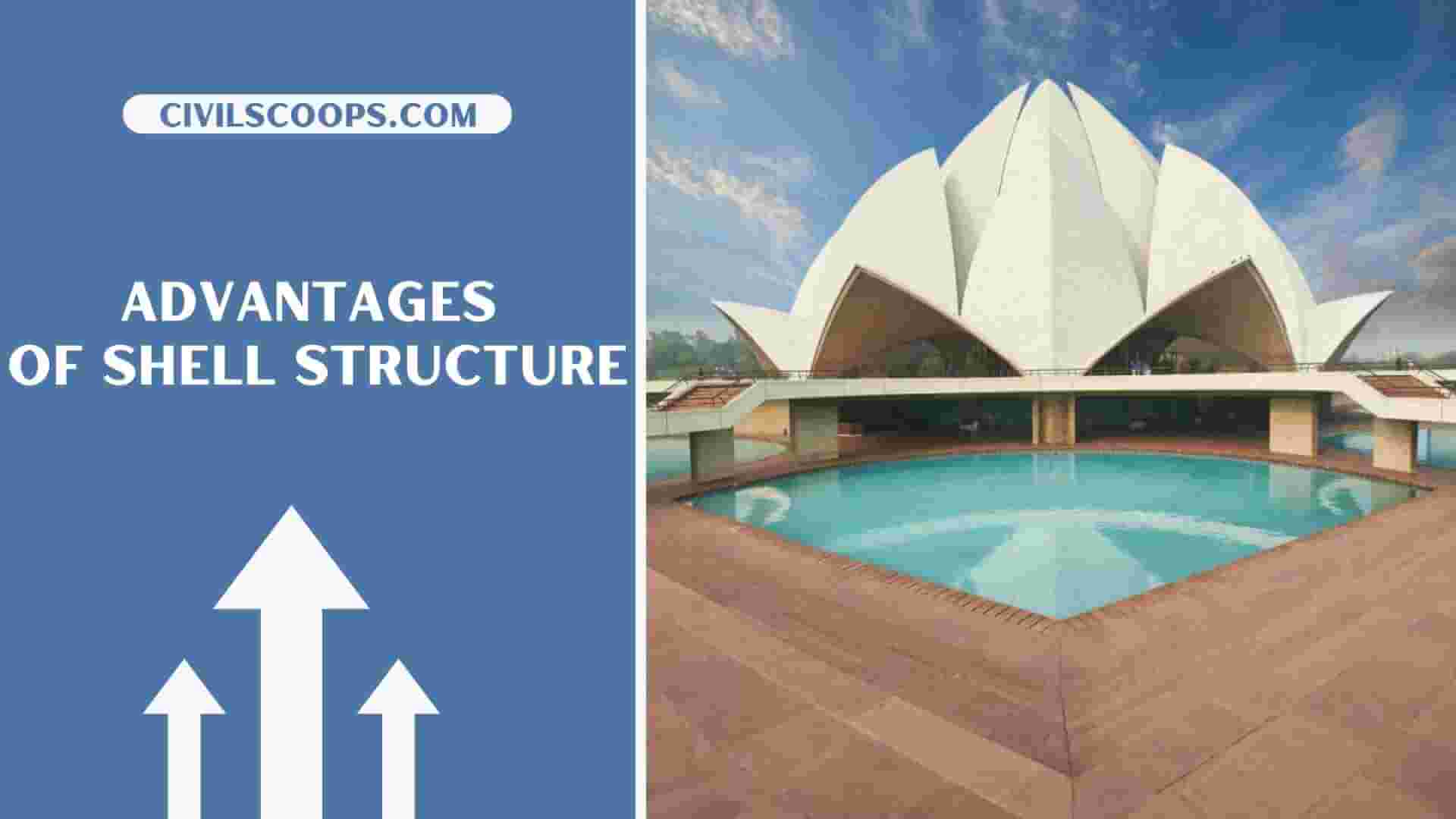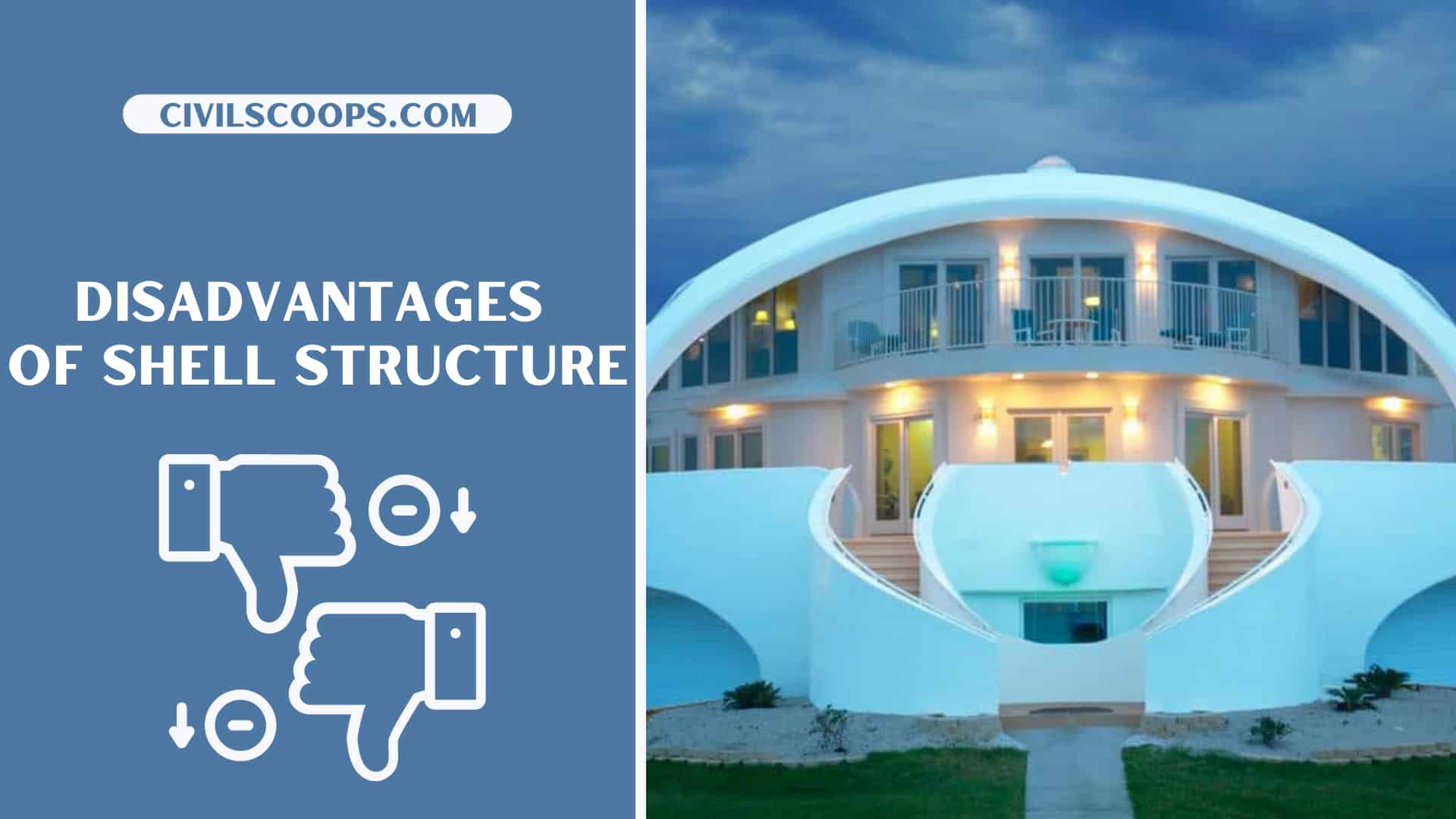What Is Shell Structure | 11 Types of Shell Structure | Applications, Advantages & Disadvantages of Shell Structure

Table of Contents
Introduction to Shell Structure
Nowadays there is a need for construction of the buildings which are in closed-form structures. The main purpose of constructing the Shell Structure that it will cover a larger area of the building.
The construction of shell structures is gaining popularity in areas where there is a high risk of earthquakes. The word ‘shell’ is commonly used to describe the outer hard covering of the egg.
In civil engineering, the shell Structure is a curved outer membrane that is used as a roof cover in buildings. Here in this article, we will go through the concept of Shell structure and its types, Advantages, and Disadvantages.
What Is Shell Structure?

The shell structure is a thin curved membrane or a slab that is usually made from the reinforced cement concrete. The shell Structure is used as both structure and covering membrane.
Shell Structures are defined as structures that are capable of maintaining their shape and the support loads without any help of the frame or the solid mass materials.
The term shell is generally used to describe structures that possess high strength and rigidity due to their thin form. The of the best feature of the shell structures is their continuity and curvature. Due to its structural continuity, the shells can transmit the loads in a number of different directions.
Shell structures are also commonly known as plate structures. Structures whose thickness is very less as per as the length and breadth of the structure are considered. These types of structures are known as thin shell structures.
The main purpose of constructing the shell structure is to reduce the self-weight of the structure by making the structure as thin as possible.
Types of Shell Structure

The shell structures are categorized into various types which are as follows.
1. Barrel Vaults of Shell Structure
The Barrel vault is one of the commonly used shell structures because of its greater span capacity. These types of Shell structures have a span capacity of upto 50m. The barrel vaults are concrete thin shells that mainly consist of the cylinder, frame at its ends including columns.
2. Folded Plates of Shell Structure
The folded plate is a type of shell structure that is made from a thin flat slab. These types of structures are generally joined along their edges to construct the three-dimensional structure.
The maximum length to which the folded plate can be constructed is up to 30 meters. The thickness of the folded plate is only 60 mm. Folded plates are one of the best attractive structure which required very less material and construction cost.
3. Faced Folded Plate of Shell Structure
Folded plate structures are assemblies of flat plates, or slabs, inclined in different directions and joined along their longitudinal edges. Modern folded plate structures are typically made of cast in situ or precast reinforced concrete, or steel plate. It consists of triangular or polygonal planar thin slabs joining along their edges to form a thin plate structure.
4. Folded Plate Dome of Shell Structure
In this category are included all domes made with plane slabs and plates. There are many variations and only a few of them can be shown here. Domes may be constructed with small angles between the plates or with large angles between plates and the structural action may be considerably different for each type.
The obvious advantage of the folded plate dome is that the surfaces are easier to form because they are flat. On the other hand, for slab spans over 16 ft, the shell wall is thicker than a curved surface because bending must be considered. The acoustical properties of a structure with plane surfaces are much better since the sound rays do not come to focus. This characteristic may be enough to make the folded plate dome superior to the curved dome for use in an auditorium.
5. Short Shell
Short shell structures basically have a cylindrical shape which has a large radius as compared to its length. The overall thickness of the shell is very thin due to its properties.
Short shells can carry the load in two different ways, the first is carrying the load to the lower elements and the second as a curved beam to the arches.
Reinforced cement concrete is used in the construction of shell structures because it is a highly plastic material. When the cement is mixed with water it will take the shape of centering and once it gets hardened, the shell membrane will act as a strong and Rigid shell structure.
6. Domes Shell
Domes are basically hemisphere in shape. The domes are generally used as a roof structure. A dome is a space structure that covers a circular area.
7. Shell Arche
Shell Arches are the type of Shell structures that are small shells. Shell Arches are not an Efficient structure for the higher value of the bending moment.
8. Cylindrical Barrel Vault of Shell Structure
Cylindrical Barrel Vaults are perhaps the most useful of the shell structures because they can span up to 150 feet with a minimum of material. they are very efficient structures because they use the arch form to reduce stresses and thicknesses in the transverse direction
9. Translation of Shell Structure
A translation shell is a dome set on four arches. The shape is different from a spherical dome and is generated by a vertical circle moving on another circle. The stresses in a translation shell are much like a dome at the top, but at the level of the arches, tension forces are offset by compression in the arch.
10. Wrapped Surfaces of Shell Structure
Warped surfaces have a great advantage for shell structures because they may be formed from straight-form boards even though they are surfaces of double curvature. There are two types that are most useful namely Conoid and hyperbolic paraboloid shell.
11. Combinations of Shell Structure
They have solid, shell, and frame parts. For example, most buildings have a solid foundation. They also have a frame of wood or metal that supports a shell of brick or concrete.
Shell Structure Examples
Shell structures are used worldwide for their unique aesthetical views.
- In India, the popular Lotus temple which is situated in Delhi is one of example of a Shell structure.
- The world-famous Opera House in Sydney is also an example of a thin shell structure.
- The Geodesic shell of Nagoya Dome in Japan.
- The Shell of Kresge Auditorium by Week Saarinen, MIT, Cambridge.
Applications of Shell Structure

There are various applications of the shell structures in the construction sector which are as follows. Shell structures are popular which are commonly used in different areas.
The shell structure is commonly used in seismic zones where structures undergo seismic loads. The reason of using the shell structures in the earthquake-prone areas is that it has high strength with respect to its self-weight.
Shell Structures are generally used to cover the larger area of the building where the interior of the building has no columns and walls to support the flat slabs
Shell Structure has a very interesting and attractive look which is used to beautify the buildings.
Advantages of Shell Structure

There are various advantages of Shell structures which are as follows.
- Shell structures have very high stiffness.
- Shell structures have higher strength with respect to their self-weight.
- Shell structures are used to cover a large area.
- It is very simple in design and has more strength as compared to other types of Structures.
- Steel structures are structurally continuous and it can transfer loads in a number of directions.
- Shell structures are attractive in appearance and mostly used for decorative purposes.
- The notes which are applied to the shell structures are carried to the ground by tensile, shear, and compressive forces.
- The dead load in the Shell structure can be reduced by economizing the foundation and the overall support system.
Disadvantages of Shell Structure

There are also some disadvantages of shell structures which are as follows.
- In the case of shell structures, it is not possible to construct a floor above them.
- The labor cost required for the construction of Shell structures is more.
- For the construction of the shell structures, there should be greater accuracy in the formwork required.
- The construction of the shell structures required Skilled labor and good supervision.
Conclusion of Shell Structure
Shell structures are one of the best and lightweight structures which are used to cover a large area of span without any supports of beams, columns, and walls.
The material which is generally used and suitable for the construction of the shell structure is concrete. Concrete is used because of its high plasticity.
[su_box title=”FAQ” style=”default” box_color=”#333333″ title_color=”#FFFFFF” radius=”3″ class=”” id=””]
Shell Structure
Shell structure, in building construction, a thin, curved plate structure shaped to transmit applied forces by compressive, tensile, and shear stresses that act in the plane of the surface. They are usually constructed of concrete reinforced with steel mesh (see shotcrete).
Shell Structure Examples
These types of structures provide fantastic architectural views, Opera house in Sydney is the world-famous thin-shell structure. In India, the Lotus temple at Delhi is, also a good example of shell structure and various shell structures bring out the miracle in building construction history.
Advantages of Shell Structure
The main advantages of reinforced concrete shell structures are the following: their efficient resistant mechanism allows that the maximum structural advantage, in terms of both internal forces and displacements, is obtained with a minimum of materials; their architectonic value is characterized by being able to cover large columns-free areas with an aesthetical and functional structure.
Disadvantages of Shell Structure
The disadvantage of shell structure is its cost. The shell structure is more expensive due to the considerable labor required to construct the centering on which the shell is cast.
What Are Examples of Shell Structures?
Shell structures are typically curved lightweight structures. Examples of natural shell structures include coconut shells, tortoise shells, sea shells, and nut shells. Examples of man-made shell structures include tunnels, roofs, helmets, drink cans, and boats.
Shell Structure Examples
What Are Examples of Shell Structures? Shell structures are typically curved lightweight structures. Examples of natural shell structures include coconut shells, tortoise shells, sea shells, and nut shells. Examples of man-made shell structures include tunnels, roofs, helmets, drink cans, and boats.
Shell Concrete Structures
A concrete shell, also called a “thin shell” concrete structure, is composed of a thin shell of concrete formed in such a way as to be self-supporting, often with no interior columns or exterior buttresses. The shells are most commonly flat plates and domes.
Famous Shell Structures
The igloo, the egg carton, and the egg shells themselves are shell structures. Some very famous structures from around the world include the Eiffel Tower, the Great Wall of China, and Mount Everest.
Natural Shell Structures
Examples of natural shell structures include coconut shells, tortoise shells, sea shells, and nut shells. Examples of man-made shell structures include tunnels, roofs, helmets, drink cans, and boats.
Thin Shell Architecture
Thin-shell structures (also called plate and shell structures) are lightweight constructions using shell elements. These elements, typically curved, are assembled to make large structures. Typical applications include aircraft fuselages, boat hulls, and the roofs of large buildings.
Thin Shell Concrete Construction
Thin shell concrete structures are pure compression structures formed from inverse catenary shapes. Catenary shapes are those taken by string or fabric when allowed to hang freely under their own weight. As string can bear no compression, the free hanging form is in pure tension.
Reinforced Concrete Shell Structures
A concrete shell, also commonly called a thin shell concrete structure, is a structure composed of a relatively thin shell or shell of concrete, usually with no interior columns or exterior buttresses.
Thin Shell Concrete Dome
Insulated Reinforced Concrete Domes, sometimes referred to as “concrete shells”, “thin shell concrete domes” or “monolithic domes” are known for their rapid construction (usually a matter of a few weeks depending on the size), economics for a cost-effective free-span structure, energy efficiency from thick insulation.
Shell Roof Construction Details Pdf
Thin-shell structures (also called plate and shell structures) are lightweight constructions using shell elements. These elements, typically curved, are assembled to make large structures. Typical applications include aircraft fuselages, boat hulls, and the roofs of large buildings.
Building Shells
What Is A Shell In Construction? The shell of a building is the component that separates the interior space of the structure from its exterior and surrounding areas. It can have a number of features, most commonly the foundation, roofing, doors, windows, and footers.
What Are the 3 Types of Structures?
Types of structures. There are three basic types of structures: shell structures, frame structures and solid structures.
[/su_box]
[su_note note_color=”#F2F2F2 ” text_color=”#333333″ radius=”3″ class=”” id=””]
Like this post? Share it with your friends!
Suggested Read –
- Stepped Footing | House Foundation on Slope | How to Build a Foundation on the Slope
- What Are Weirs | Types of Weirs | Advantages & Disadvantages of Weirs | Operation & Limitations For Weir | Limitations of Weirs | Location of Weirs
- What Is Sealing Brick Work| Advantages of Brick Sealer | Types of Brick Sealer
- 15 Different Types of Cement and Their Uses
- 10 Different Between Mortar And Concrete | What Is Mortar & Concrete | Types of Mortar & Concrete
[/su_note]
Originally posted 2022-09-08 13:28:17.
